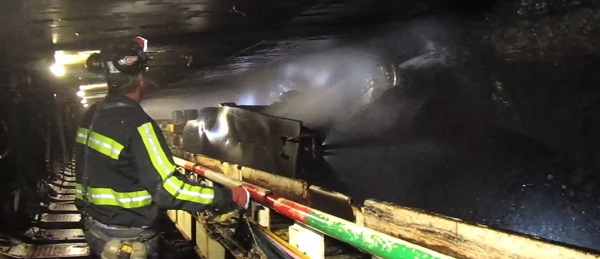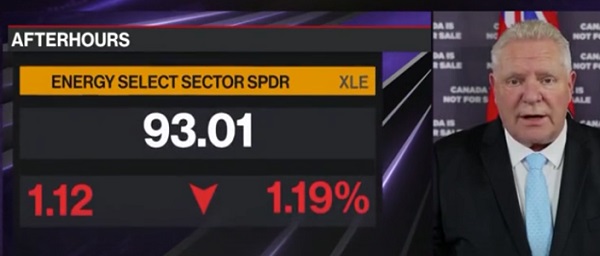Energy
Dig, Baby, Dig: Making Coal Great Again. A Convincing Case for Coal


From the Daily Caller News Foundation
By Gordon Tomb
Has the time come to make coal great again? Maybe.
“Coal is cheap and far less profitable to export than to burn domestically. so, let’s burn it here,” says Steve Milloy, a veteran observer of the energy industry who served on the Environmental Protection Agency (EPA) transition team for the first Trump administration. “It will provide an abundance of affordable and reliable electricity while helping coal communities thrive for the long term.”
The U.S. coal industry has been in a long decline since at least President Barack Obama’s regulatory “war on coal” initiated 15 years ago. At the same time, natural gas became more competitive with coal as a power-plant fuel when new hydrofracturing techniques lowered the price of the former.
In Pennsylvania, a state with prodigious amounts of both fuels, natural gas has all but replaced coal for electric generation. Between 2001 and 2021, gas’ share of power production rose from 2% to 52% as coal’s dropped from 57% to 12%, according to the U.S. Energy Information Administration. Last year, Pennsylvania’s largest coal-fired power plant shut down under the pressures of regulations and economics after spending nearly $1 billion on pollution controls in the preceding decade.
Nationally, between 2013 and 2023, domestic coal production declined by more than 30% and industry employment by more than 40%.
While the first Trump administration provided somewhat of a respite from federal hostility toward fossil fuels in general and coal in particular, President Joe Biden revived Obama’s viciously negative stance on hydrocarbons while promoting weather-dependent wind and solar energy. This absurdity has wrecked livelihoods and made the power grid more prone to blackouts.
Fortunately, the second Trump administration will be exponentially more friendly toward development of fossil fuels. High on the list is increasing exports of liquefied natural gas (LNG). “[T]he next four years could prime the liquefied natural gas (LNG) markets for a golden era,” says market analyst Rystad Energy. “[T]he returning president’s expected policies are likely to accelerate U.S. LNG infrastructure expansion through deregulation and faster permitting…”
All of which is in line with Milloy’s formulation of energy policy. We should “export our gas to Europe and Asia, places that will pay six times more than it sells for in the U.S.” says Milloy, publisher of JunkScience.com and author of books on regulatory overreach, fearmongering and corruption. “Let’s reopen mothballed coal plants, build new coal plants…”
Accompanying rising expectations of easing regulatory obstacles for natural gas is hope that coal can clear daunting environmental hurdles put in place by “green” zealots.
For one thing, the obnoxiously irrational EPA rule defining carbon dioxide — a byproduct of combustion — as a pollutant is destined for the dustbin of destructive policy as common sense and honest science are reestablished among regulators.
Moreover, clean-coal technology makes the burning of the fuel, well, clean. China and India have more than 100 ultra-super critical coal-fired plants that employ high pressures and temperatures to achieve extraordinary efficiencies and minimal pollution. Yet, the United States, which originated the technology more than a decade ago, has only one such facility — the John W. Turk plant in Arkansas.
The point is the United States is underutilizing both coal and the best technology for its use. At the current rate of consumption, the nation’s 250 billion tons of recoverable coal is enough for more than 200 years.
So, if more natural gas winds up being exported as LNG at higher prices, might not coal be an economical — and logical — alternative?
Nuclear power is another possibility, but not for a while. Even with a crash development program and political will aplenty, it is likely to take decades for nuclear reactors to be deployed sufficiently to carry the bulk of the nation’s power load. Barriers range from the need to sort out competing nuclear technologies to regulatory lethargy —if not misfeasance — to financing needs in the many billions and a dearth of qualified engineers.
The last big U.S. reactors to go into operation — units 3 and 4 of Georgia Power’s Vogtle plant — took more than a decade to build and went $17 billion over budget.
“The regulatory environment is better, but it still costs too much and takes too long to get new reactors approved,” writes long-time nuclear enthusiast Robert Bryce.
Can anybody say, “Dig, baby, dig?”
Gordon Tomb is a senior advisor with the CO2 Coalition, Fairfax, Virginia, and once drove coal trucks.
2025 Federal Election
Poilievre To Create ‘Canada First’ National Energy Corridor

From Conservative Party Communications
Poilievre will create the ‘Canada First’ National Energy Corridor to rapidly approve & build the infrastructure we need to end our energy dependence on America so we can stand up to Trump from a position of strength.
Conservative Leader Pierre Poilievre announced today he will create a ‘Canada First’ National Energy Corridor to fast-track approvals for transmission lines, railways, pipelines, and other critical infrastructure across Canada in a pre-approved transport corridor entirely within Canada, transporting our resources within Canada and to the world while bypassing the United States. It will bring billions of dollars of new investment into Canada’s economy, create powerful paycheques for Canadian workers, and restore our economic independence.
“After the Lost Liberal decade, Canada is poorer, weaker, and more dependent on the United States than ever before,” said Poilievre. “My ‘Canada First National Energy Corridor’ will enable us to quickly build the infrastructure we need to strengthen our country so we can stand on our own two feet and stand up to the Americans.”
In the corridor, all levels of government will provide legally binding commitments to approve projects. This means investors will no longer face the endless regulatory limbo that has made Canadians poorer. First Nations will be involved from the outset, ensuring that economic benefits flow directly to them and that their approval is secured before any money is spent.
Between 2015 and 2020, Canada cancelled 16 major energy projects, resulting in a $176 billion hit to our economy. The Liberals killed the Energy East pipeline and passed Bill C-69, the “No-New-Pipelines” law, which makes it all but impossible to build the pipelines and energy infrastructure we need to strengthen the Canadian economy. And now, the PBO projects that the ‘Carney cap’ on Canadian energy will reduce oil and gas production by nearly 5%, slash GDP by $20.5 billion annually, and eliminate 54,400 full-time jobs by 2032. An average mine opening lead time is now nearly 18 years—23% longer than Australia and 38% longer than the US. As a result of the Lost Liberal Decade, Canada now ranks 23rd in the World Bank’s Ease of Doing Business Index for 2024, a seven-place drop since 2015.
“In 2024, Canada exported 98% of its crude oil to the United States. This leaves us too dependent on the Americans,” said Poilievre. “Our Canada First National Energy Corridor will get us out from under America’s thumb and enable us to build the infrastructure we need to sell our natural resources to new markets, bring home jobs and dollars, and make us sovereign and self-reliant to stand up to Trump from a position of strength.”
Mark Carney’s economic advice to Justin Trudeau made Canada weaker while he and his rich friends made out like bandits. While he advised Trudeau to cancel Canadian energy projects, his own company spent billions on pipelines in South America and the Middle East. And unlike our competitors Australia and America, which work with builders to get projects approved, Mark Carney and Steven Guilbeault’s radical “keep-it-in-the-ground” ideology has blocked development, killed jobs, and left Canada dependent on foreign imports.
“The choice is clear: a fourth Liberal term that will keep our resources in the ground and keep us weak and vulnerable to Trump’s threats, or a strong new Conservative government that will approve projects, build an economic fortress, bring jobs and dollars home, and put Canada First—For a Change.”
2025 Federal Election
Canada Continues to Miss LNG Opportunities: Why the World Needs Our LNG – and We’re Not Ready

From EnergyNow.Ca
By Katarzyna (Kasha) Piquette, Founder and CEO, Canadian Energy Ventures
When Russia invaded Ukraine in 2022, Europe’s energy system was thrown into chaos. Much of the 150 billion cubic meters of Russian gas that once flowed through pipelines had to be replaced—fast. Europe turned to every alternative it could find: restarting coal and nuclear plants, accelerating wind and solar approvals, and most notably, launching a historic buildout of LNG import capacity.
Today, LNG terminals are built around the world. The ‘business case’ is solid. The ships are sailing. The demand is real. But where is Canada?
As of March 28, 2025, natural gas prices tell a story of extreme imbalance. While Europe and Asia are paying around $13 per million BTU, prices at Alberta’s AECO hub remain below $2.20 CAD per gigajoule—a fraction of global market levels. This is more than a pricing mismatch. It’s a signal that Canada, a country rich in natural gas and global goodwill, is failing to connect the dots between energy security abroad and economic opportunity at home.
Since 2022, Europe has added over 80 billion cubic meters of LNG import capacity, with another 80 billion planned by 2030. This infrastructure didn’t appear overnight. It came from urgency, unity, and massive investment. And while Europe was preparing to receive, Canada has yet to build at scale to supply.
We have the resource. We have the relationships. What we lack is the infrastructure.
Estimates suggest that $55 to $75 billion in investment is needed to scale Canadian LNG capacity to match our potential as a global supplier. That includes pipelines, liquefaction terminals, and export facilities on both coasts. These aren’t just economic assets—they’re tools of diplomacy, climate alignment, and Indigenous partnership. A portion of this investment can and should be met through public-private partnerships, leveraging government policy and capital alongside private sector innovation and capacity.
Meanwhile, Germany continues to grapple with the complexities of energy dependence. In January 2025, German authorities seized the Panama-flagged tanker Eventin, suspected of being part of Russia’s “shadow fleet” used to circumvent oil sanctions. The vessel, carrying approximately 100,000 tons of Russian crude oil valued at €40 million, was found adrift off the Baltic Sea island of Rügen and subsequently detained. This incident underscores the ongoing challenges Europe faces in enforcing energy sanctions and highlights the pressing need for reliable, alternative energy sources like Canadian LNG.
What is often left out of the broader energy conversation is the staggering environmental cost of the war itself. According to the Initiative on GHG Accounting of War, the war in Ukraine has produced over 230 million tonnes of CO₂ equivalent (MtCO₂e) since 2022—a volume comparable to the combined annual emissions of Austria, Hungary, the Czech Republic, and Slovakia. These emissions come from military operations, destruction of infrastructure, fires, and the energy used to rebuild and support displaced populations. Yet these emissions are largely absent from official climate accounting, exposing a major blind spot in how we track and mitigate global emissions.
This is not just about dollars and molecules. This is about vision. Canada has an opportunity to offer democratic, transparent, and lower-emission energy to a world in flux. Canadian LNG can displace coal in Asia, reduce reliance on authoritarian suppliers in Europe, and provide real returns to our provinces and Indigenous communities. There is also growing potential for strategic energy cooperation between Canada, Poland, and Ukraine—linking Canadian LNG supply with European infrastructure and Ukrainian resilience, creating a transatlantic corridor for secure and democratic energy flows.
Moreover, LNG presents Canada with a concrete path to diversify its trade relationships, reducing overdependence on the U.S. market by opening new, high-value markets in Europe and Asia. This kind of energy diplomacy would not only strengthen Canada’s strategic position globally but also generate fiscal capacity to invest in national priorities—including increased defense spending to meet our NATO commitments.
Let’s be clear: LNG is not the endgame. Significant resources are being dedicated to building out nuclear capacity—particularly through Small Modular Reactors (SMRs)—alongside the rapid expansion of renewables and energy storage. But in the near term, LNG remains a vital bridge, especially when it’s sourced from a country committed to environmental responsibility, human rights, and the rule of law.
We are standing at the edge of a global shift. If we don’t step up, others will step in. The infrastructure gap is closing—but not in our favor.
Canada holds the key. The world is knocking. It’s time we opened the door.

Sources:
- Natural Gas Prices by Region (March 28, 2025): Reuters
- European LNG Import Capacity Additions: European Commission
- German Seizure of Russian Shadow Fleet Tanker: Reuters
- War Emissions Estimate (230 MtCO₂e): Planetary Security Initiative
-

 2025 Federal Election1 day ago
2025 Federal Election1 day agoCanada Continues to Miss LNG Opportunities: Why the World Needs Our LNG – and We’re Not Ready
-

 International7 hours ago
International7 hours agoGermany launches first permanent foreign troop deployment since WW2
-

 COVID-192 days ago
COVID-192 days agoTrump’s new NIH head fires top Fauci allies and COVID shot promoters, including Fauci’s wife
-

 Freedom Convoy2 days ago
Freedom Convoy2 days agoFreedom Convoy leaders Tamara Lich, Chris Barber found guilty of mischief
-

 2025 Federal Election10 hours ago
2025 Federal Election10 hours agoPoilievre To Create ‘Canada First’ National Energy Corridor
-

 2025 Federal Election1 day ago
2025 Federal Election1 day agoMainstream Media Election Coverage: If the Election Was a NHL Game, the Ice Would be Constantly Tilted Up and to the Left
-

 Business2 days ago
Business2 days ago‘Time To Make The Patient Better’: JD Vance Says ‘Big Transition’ Coming To American Economic Policy
-

 2025 Federal Election2 days ago
2025 Federal Election2 days agoPoilievre promises to drop ‘radical political ideologies’ in universities






